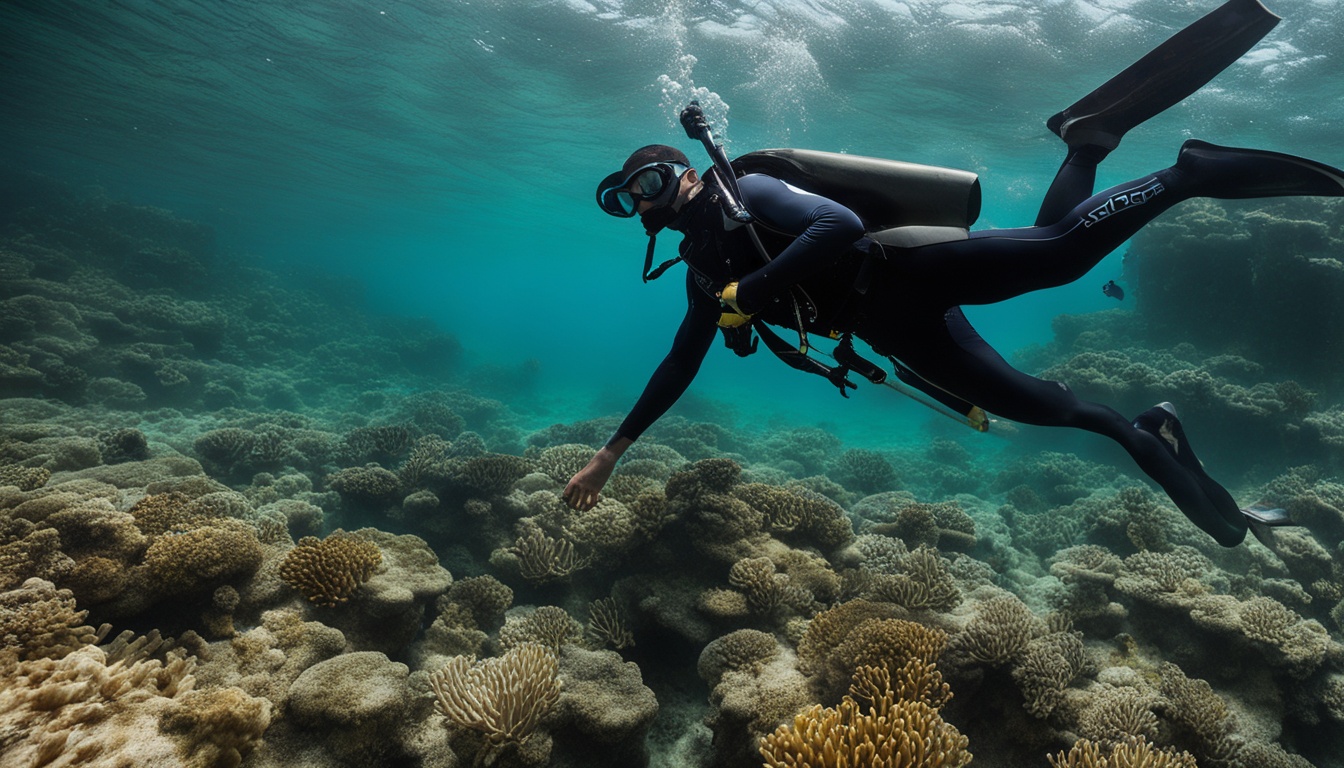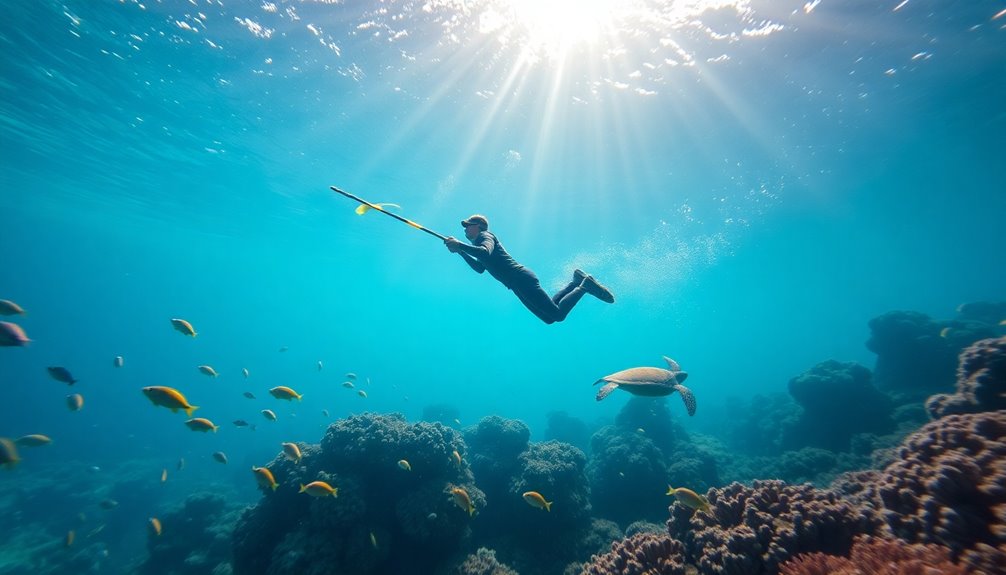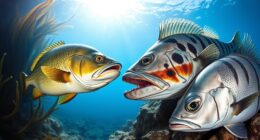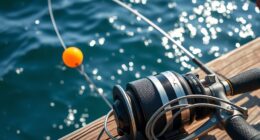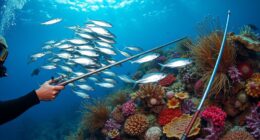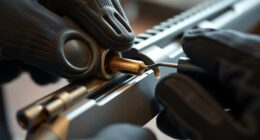Spearfishing in Queensland offers thrilling adventures in its diverse marine ecosystems. From the tropical waters of the Great Barrier Reef to the temperate seas of Tasmania, there are plenty of opportunities for spearfishers to explore. Whether you’re a beginner looking to try your hand at shore diving or an experienced spearo seeking new challenges, Queensland has something for everyone.
Imagine this: You wake up early, filled with anticipation, and pack your spearfishing gear into the car. Today, you’re heading to one of Queensland’s renowned spearfishing spots, known for its abundant marine life and crystal-clear waters. As you make your way to the coast, you can’t help but feel excited about the possibilities that lie beneath the surface.
Upon arrival, you meet up with your experienced spearfishing buddy, Matt, who’s been your go-to partner for these underwater adventures. You both share a passion for the sport and have spent countless hours honing your skills together. Having a reliable partner by your side not only enhances safety but also adds to the enjoyment of the experience.
Before you slip into the water, you take a moment to assess the conditions. The winds are calm, with hardly a ripple on the surface. You know that wind speeds under 10 knots are considered ideal for shore diving, providing better visibility and easier entry into the water. You’re also mindful of swell, which can impact water visibility and make entry and exit points more challenging.
Equipped with your speargun, you descend into the sheltered waters near a rocky point. These sheltered areas, like the side of a headland or an estuary, offer protection from strong currents and provide a haven for various fish species. You’ve done your research, using tools like Google Earth and the Navionics app to identify the best locations for spearfishing.
As you immerse yourself in the underwater world, you marvel at the vibrant colors and the abundance of marine life. You spot schools of colorful fish darting between coral formations, and elusive creatures like octopuses hiding in crevices. The thrill of the hunt combines with the beauty of the surroundings, creating a truly immersive experience.
After a successful dive, you resurface, triumphantly holding a coral trout you’ve just speared. It’s a prized catch, one that will provide a delicious meal for you and your friends. As you make your way back to shore, you can’t help but feel grateful for this incredible sport and the unique adventures it offers.
Key Takeaways:
- Shore diving or rock-hopping is a popular method of spearfishing in Queensland.
- Finding an experienced spearfishing buddy is essential for a successful trip.
- Sheltered waters like rocky points and estuaries are ideal locations for shore dive spearfishing.
- Tools like Google Earth and the Navionics app are recommended for spearfishing reconnaissance.
- Wind speeds under 10 knots are generally considered ideal for shore diving.
Planning and Preparation for Shore Dive Spearfishing
Before embarking on your shore dive spearfishing adventure, it’s essential to plan and prepare accordingly. Whether you’re a seasoned spearo or a beginner, taking the time to properly prepare will enhance your overall experience and ensure your safety. Here are some key factors to consider:
Finding an Experienced Spearo as Your Buddy
Having a reliable spearfishing buddy by your side is crucial, especially if you’re new to the sport. You can find experienced spearos through local spearfishing retailers, spearfishing forums, or spearfishing clubs. Connecting with someone who has ample experience will not only provide valuable guidance but also enhance the safety of your dive.
Planning Entry and Exit Points
When shore diving, it’s important to carefully plan your entry and exit points. Research the dive locations beforehand and identify multiple alternatives in case the conditions change. By having pre-determined points, you can ensure a smoother and safer diving experience.
Choosing the Right Equipment
Selecting the right equipment is vital for a successful spearfishing trip. Opt for a hard float that is easily visible for resting and safety purposes. Some spearos prefer plastic or poly coated float-lines over rope due to their durability and visibility. Additionally, fiberglass or plastic fins are recommended for shore diving to mitigate potential entanglement risks. Keep in mind that booties, being an essential equipment part, tend to wear out quickly in shore diving. Make sure to have a spare pair.
Observation First, Gun Handling Later
If you’re a first-timer, it’s recommended to prioritize observation over handling a gun initially. Take the time to familiarize yourself with the underwater environment, fish behavior, and the diving techniques employed by experienced spearos. This observation phase will lay a solid foundation for your future spearfishing endeavors.
By taking these planning and preparation steps, you’ll be well-equipped to venture into the world of shore dive spearfishing. Section 3 will delve into the importance of location and reconnaissance when it comes to successful spearfishing in Queensland.
Location and Reconnaissance for Spearfishing in Queensland
When it comes to spearfishing in Queensland, finding the perfect spot is key to a successful and thrilling adventure. To ensure you make the most out of your spearfishing reconnaissance, here are some tips and tools to help you locate the ideal dive locations.
1. Utilize Online Tools: Take advantage of the three free online tools recommended by Clancy Bowman to find secret spearfishing spots. These tools can provide valuable insights into the best locations, local conditions, and even fish behavior in various areas.
| Tool | Description |
|---|---|
| Google Earth | Use the satellite imagery and mapping features of Google Earth to scout for sheltered waters and identify potential reef structures. |
| Navionics app | This app allows you to explore nautical charts, plan your entry and exit points, and assess the depth and bottom contour of your desired dive sites. |
| Marine Protection Zones Info | Research and familiarize yourself with the marine protection zones in the area you plan to dive. This knowledge will help you understand any restrictions or permissions required for specific activities. |
2. Consider Sheltered Waters: Especially for beginners, sheltered waters offer a safe and calm environment to develop your spearfishing skills. Look for areas such as the sheltered side of a headland or an island, which provide protection from strong currents and waves.
3. Pay Attention to Reef Structure: Using the tools mentioned above, identify reef structures in your chosen dive area. Reefs not only attract and host a variety of fish species but also provide opportunities for camouflage and ambush techniques during your dives.
4. Be Mindful of Boat Traffic: Before you head out, it’s crucial to be aware of boat traffic in the area. Avoid diving in popular boating routes or near busy water channels to ensure your safety and avoid any potential conflicts.
Remember to respect the marine protection zones and adhere to the rules and regulations established by the Great Sandy Marine Park Zoning Plan. This plan designates different zones in the park, ranging from general use zones to marine national park zones, each with specific levels of protection and permissions for certain activities.
By combining your spearfishing reconnaissance skills with the provided online tools and knowledge of marine protection zones, you can confidently explore the beautiful waters of Queensland while enjoying a safe and sustainable spearfishing experience.

Understanding Conditions for Spearfishing in Queensland
To have a successful spearfishing adventure in Queensland, it’s essential to understand the conditions that can significantly impact your experience. Local knowledge plays a crucial role in staying informed and making informed decisions. Here are some key factors to consider:
Water Visibility
The visibility of the water is a critical factor in spearfishing. Clear water allows for better target identification and accurate shots. In Queensland, water visibility can vary depending on factors such as currents, tides, and weather conditions. To gauge water visibility, check with local spearos, join forums or social media groups, and consult local dive shops for up-to-date information.
Wind and Swell
Wind and swell conditions can affect the accessibility and safety of spearfishing locations. Strong winds can create choppy and rough seas, making it challenging to navigate and dive comfortably. Large swells can impact the clarity of the water and increase the difficulty of maintaining balance underwater. Monitoring wind and swell conditions is crucial before heading out. Use marine forecasts and weather sites like the Bureau of Meteorology (BOM) or SeeBreeze to stay informed and plan your dives accordingly.
Marine Forecasts and Weather Sites
Utilize reliable marine forecast websites to access accurate and up-to-date weather information. The Bureau of Meteorology (BOM), SeeBreeze, and WillyWeather provide comprehensive data on wind speed, swell conditions, tide times, and other relevant information. These forecasts will help you determine the optimal time and locations for your spearfishing adventures.
Remember, weather conditions can change rapidly, so it’s essential to check for updates before and during your dive. Stay vigilant and prioritize your safety above all else.

Essential Equipment for Spearfishing in Queensland
To fully enjoy the thrill and adventure of spearfishing in Queensland, it is essential to have the right equipment. Whether you are a beginner or an experienced spearfisher, having the proper gear will enhance your safety, comfort, and overall experience in the water.
Spear Gun or Pole Spear: The spear gun or pole spear is the primary tool used in spearfishing. The spear gun allows you to shoot the fish directly, while the pole spear requires you to get closer to your target. Choose the option that suits your style and skill level.
Diving Mask and Snorkel: A good quality diving mask and snorkel are essential for clear vision and efficient underwater breathing. Look for a mask that fits well and provides a comfortable seal, while the snorkel should have a comfortable mouthpiece and a purge valve for easy clearing.
Wetsuit: Queensland waters can be chilly, even in the warmer months. A wetsuit between 3-5mm thick will provide insulation and protection from the elements, allowing you to stay in the water for longer periods comfortably.
Fins: Choosing the right pair of fins is crucial for efficient movement underwater. Opt for fins that are comfortable, fit well, and provide the necessary propulsion for easy maneuverability. Closed-heel fins are ideal for spearfishing as they offer a secure fit.
Weight Belt: A weight belt helps you achieve proper buoyancy control while diving. It allows you to descend easily and maintain a comfortable depth during your spearfishing adventures. Ensure that the weight belt is adjustable and has quick-release mechanisms for safety.
Dive Knife: Safety should always be a top priority when spearfishing. A dive knife is an essential tool for cutting through entanglements or freeing yourself from underwater obstacles. Choose a durable and corrosion-resistant knife that can be easily accessed during emergencies.
Float and Line: A float and line serve multiple purposes during spearfishing. They help you mark your location, indicate your presence to other divers or boats, and hold your catch securely. Opt for a high-visibility float and a durable line that can withstand the pressures of the water.
Investing in quality equipment that suits your needs and preferences is key to a successful spearfishing experience in Queensland. Remember to check and adhere to local regulations and marine protected areas to ensure ethical and sustainable fishing practices. Happy spearfishing!

Safety Tips for Spearfishing in Queensland
When it comes to spearfishing in Queensland, safety should always be a top priority. By following a few essential tips, you can ensure a safe and enjoyable experience on your spearfishing adventures.
Dive with a Buddy
One of the most important safety measures in spearfishing is to always dive with a buddy. Having a dive buddy not only enhances the enjoyment of the sport but also provides an extra layer of security in case of emergencies. Your dive buddy can assist you in case of equipment malfunctions or other incidents that may arise while underwater.
Know the Marine Life and Weather Conditions
Before heading out, take the time to educate yourself about the local marine life and weather conditions. Understanding the behavior of different species and their habitats can help you make informed decisions while spearfishing. Additionally, staying updated on weather forecasts and current sea conditions is crucial for ensuring your safety and well-being while out in the water.
Learn First Aid and CPR
Being prepared for any situation is important, especially when engaging in a sport like spearfishing. It is highly recommended to learn basic first aid techniques and CPR. These skills can be invaluable in case of emergencies, allowing you to provide immediate assistance to yourself or others until professional help arrives.

Stay Within the Regulations
Adhering to the regulations and guidelines set forth for spearfishing is essential for protecting the natural environment and ensuring sustainable fishing practices. Familiarize yourself with the specific rules and restrictions in the area you plan to spearfish, such as size and bag limits, restricted zones, and prohibited equipment. This will contribute to the long-term preservation of marine life and the overall health of the ecosystem.
Invest in Quality Equipment
Having the right equipment is crucial for both safety and success in spearfishing. Invest in robust and user-friendly gear that suits your needs and budget. Consider factors such as the type of fish you are targeting and the diving conditions you will encounter. Additionally, make sure your equipment is properly maintained and regularly inspected to ensure its reliability and functionality.
By following these safety tips and always prioritizing your well-being, you can fully enjoy the exhilarating experience of spearfishing in Queensland while minimizing risks.
Techniques for Successful Spearfishing in Queensland
Mastering the techniques of spearfishing is key to a successful adventure in the waters of Queensland. By understanding freediving basics, spearfishing techniques, fish behavior, habitat, aiming, and shooting, you can greatly increase your chances of a fruitful catch. Let’s explore some essential techniques to enhance your spearfishing skills.
1. Freediving Basics
Freediving is an integral part of spearfishing. Learning how to effectively hold your breath and dive underwater is essential for approaching fish and making accurate shots. Practice breath-holding exercises and focus on relaxation techniques to improve your freediving abilities.
2. Understanding Fish Behavior and Habitat
Knowing the behavior and preferred habitats of the species you’re targeting is crucial for a successful spearfishing experience. In Queensland waters, species such as Luderick, Flathead, Bream, Tarwhine, Parrot, Tuskfish, Surgeonfish, and Morwong are commonly sought after. Research their habits, feeding patterns, and preferred locations to increase your chances of finding and approaching them.
3. Aiming and Shooting
Developing accurate aiming and shooting skills is essential in spearfishing. Practice regularly to improve your accuracy and precision. Consider using a speargun that is suitable for your skill level, with a recommended size of around 950mm for beginners. Explore different spear tips, such as the single-pronged shaft (Tahitian) and the three-pronged paralyser, to find the most effective option for your preferred hunting style.

4. Safety and Conservation
As with any adventure sport, safety is paramount in spearfishing. Always dive with a buddy, regardless of your experience level, to ensure mutual safety and assistance. Familiarize yourself with spearfishing regulations in Queensland and follow sustainable fishing practices to protect the marine environment for future generations.
By mastering these techniques and skills, you’ll be well-equipped to embark on a successful spearfishing adventure in the beautiful waters of Queensland. Remember to always prioritize safety, respect the marine environment, and enjoy the thrill of the hunt while preserving the delicate balance of aquatic life.
Understanding Spearfishing Regulations in Queensland
When embarking on a spearfishing adventure in Queensland, it’s important to have a solid understanding of the regulations that govern this recreational activity. By adhering to these guidelines, you can ensure sustainable fishing practices and contribute to the preservation of the marine ecosystem.
First and foremost, it’s essential to determine whether you need a fishing license. Queensland requires recreational fishers, including spearfishers, to hold a valid fishing license. Obtaining a license not only ensures legal compliance but also supports conservation efforts by funding the management and protection of fish stocks and their habitats.
Once you have the necessary fishing license, you must familiarize yourself with the size and bag limits for different species. These limits vary depending on the type of fish and the location where you are spearfishing. Adhering to these limits helps maintain healthy fish populations and prevents overfishing.
Additionally, it’s crucial to be aware of protected species in Queensland. These protected species are off-limits for spearfishing, and catching them can result in significant fines and penalties. By understanding which species are protected, you can avoid targeting them and contribute to the conservation of vulnerable marine life.
To further illustrate the importance of these regulations, let’s take a closer look at some specific guidelines:
| Regulation | Details |
|---|---|
| Minimum Size Limits | Some species, like blue spot coral trout, have minimum size limits. For example, blue spot coral trout over 80 centimeters are off-limits for spearfishing. |
| Possession Limits | Possession limits dictate the maximum number of fish an individual can have in their possession on a given day. These limits are enforced to ensure sustainable fishing practices. |
| Bag Limits | Bag limits determine the number of fish a person can carry while out on a boat or diving in a specific location. Adhering to these limits helps protect fish populations. |
| Fishing Hours | In certain areas, fishing hours may be restricted. For example, actively pursuing barramundi outside of 6:00 AM to 6:00 PM is prohibited. It’s important to be aware of these time restrictions to avoid any legal issues. |
It’s worth noting that spearfishing regulations may vary across states, so it’s essential to research and adhere to the specific rules and guidelines applicable to Queensland. This knowledge will ensure your activities align with legal requirements and contribute to the conservation and preservation of Queensland’s marine resources. In addition, complying with these regulations promotes sustainable fishing practices, helping to maintain healthy fish populations for future generations. Similarly, if you plan to fish in other regions, it’s important to familiarize yourself with specific rules, such as the spearfishing rules in Western Australia, which may differ from those in Queensland. Always stay informed and respect local laws to minimize your impact on marine ecosystems.

Best Spearfishing Spots in Queensland
Queensland is a spearfishing paradise, offering a wide range of locations across its various regions. Whether you’re a beginner looking to hone your skills or an experienced diver seeking new challenges, Queensland has something for everyone. From the stunning Great Barrier Reef and its surrounding islands to the picturesque Sydney’s Northern Beaches and South Coast, the spearfishing opportunities are endless.
If you find yourself in North Queensland, make sure to check out Mackay. This region offers both shore and boat spearfishing options, with targets including Barramundi, Fingermark, Mangrove Jack, and Coral Trout. You can enjoy the thrill of diving into crystal-clear waters and encountering an abundance of marine life.
In Cairns, while shore spearfishing may be limited due to visibility concerns, boat spearfishing is a popular choice. Here, you have the chance to catch species like Mackerel, Parrot Fish, Trout, and Mangrove Jacks. The vibrant underwater world of Cairns awaits you.
Further south, in Bundaberg, you’ll find productive shore and boat spearfishing spots. Crayfish, Mangrove Jack, Barramundi, and Parrot Fish are some of the common targets here. Grab your gear and dive into the action!
If you venture to 1770, you’ll be rewarded with the opportunity to encounter species like Kingfish, Mackerel, Cobia, and Trevally. Winter usually brings clear diving conditions, allowing you to explore the rich underwater ecosystem.
Gladstone offers fantastic boat spearfishing opportunities, with a variety of species like Tuskfish, Jewfish, Coral Trout, and Mackerel commonly found in the area. It’s a must-visit destination for avid spearfishers.
While Yeppoon may have limited shore spearfishing due to poor visibility conditions, certain boat-accessible areas open up opportunities to catch species like Trout, Tuskfish, and Mackerel. Don’t miss out on this hidden gem!
Gold Coast is a popular destination for both shore and boat spearfishing. From Jewfish, Mangrove Jacks, Bream, and Tailor to Pelagic species like Cobia, Wahoo, and Sailfish, there is an incredible variety of catches waiting for you. Enjoy the thrill of spearfishing against the backdrop of stunning coastal scenery.
If you’re in Brisbane, make sure to explore the productive boat spearfishing experiences the area has to offer. Moreton Island and Stradbroke Island are known for providing access to species such as Spanish Mackerel, Cobia, Job Fish, Parrot Fish, and Mangrove Jack. Get ready for an unforgettable spearfishing adventure.
Remember to connect with fellow spearfishing enthusiasts in Southern Queensland through the Southern Queensland Spearfishing Facebook page. It’s a valuable resource for networking and sharing information.
For beginners, the Outer Seaway Spit Walls in the Gold Coast area are highly recommended. These spots are ideal for shore diving and offer a diverse spearfishing experience. Explore the underwater world at your own pace.
To ensure you have the right equipment for your spearfishing adventures, check out Dive Warehouse in Bundall and Adreno Gold Coast. These prominent dive shops cater to the needs of spearfishers in the Gold Coast region.
It’s important to stay informed about spearfishing regulations. Recently, there has been debate surrounding the legality of taking crayfish while spearfishing in yellow zones of the Great Barrier Reef Marine Park Authority (GBRMPA). To clarify this issue, consult the GBRMPA guidelines and adhere to the bag limits and restrictions in place.
If you require medical assistance related to diving, there are esteemed Dive Doctors available in South East Queensland (SEQ). Dr. Cameron Osborne in Greenslopes, Dr. Matthew Broadhurst specialized in ENT, Dr. Christopher Perry at Watkins Medical Center, and Dr. Keyoren Fernandes in Spring Hill are trusted professionals who can provide expert care.
For further information and engagement with the spearfishing community, explore various spearfishing-related posts and podcasts. Gain insights, tips, and inspiration for your next dive in the beautiful waters of Queensland.

| Region | Notable Spearfishing Species |
|---|---|
| Mackay | Barramundi, Fingermark, Mangrove Jack, Coral Trout |
| Cairns | Mackerel, Parrot Fish, Trout, Mangrove Jacks |
| Bundaberg | Crayfish, Mangrove Jack, Barramundi, Parrot Fish |
| 1770 | Kingfish, Mackerel, Cobia, Trevally |
| Gladstone | Tuskfish, Jewfish, Coral Trout, Mackerel |
| Yeppoon | Trout, Tuskfish, Mackerel |
| Gold Coast | Jewfish, Mangrove Jacks, Bream, Tailor |
| Brisbane | Spanish Mackerel, Cobia, Job Fish, Parrot Fish, Mangrove Jack |
Conclusion
Spearfishing in Australia, particularly in Queensland, offers a thrilling and sustainable fishing adventure that allows you to truly immerse yourself in the beauty of the underwater world. While commercial spearfishing is banned across all Australian states, recreational spearfishing is still permitted in certain areas, providing an opportunity for responsible fishing practices.
By adhering to sustainable fishing methods and regulations, spearfishers can minimize their impact on marine ecosystems and ensure the long-term viability of fish populations. Spearfishing is highly selective, targeting specific species and sizes, which means there is minimal direct impact on non-target species. However, studies have shown that spearfishing can have significant effects on target fish populations, such as coral trout, leading to reductions in density and size.
As spearfishing continues to gain popularity in Australia, it is crucial to balance the thrill of the sport with the conservation of our marine environments. Implementing precautionary measures, such as conducting prior reviews and authorizations for fishing activities, and expanding marine no-take areas can provide adequate protection for our marine ecosystems. By embracing sustainable fishing practices, spearfishers can enjoy thrilling adventures while preserving the natural beauty of Australia’s underwater world.


